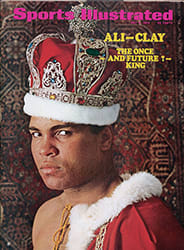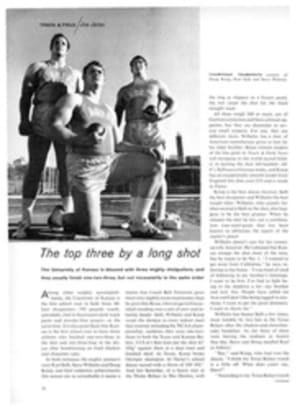The Art of Ali
There is a classical way to make every move known to boxing, but no prizefighter ever has fought entirely by the book. Among heavyweights, Gene Tunney came close, with a style as stilted as his prose, and twice beat the crowding, crouching, slugging Jack Dempsey. And there was Rocky Marciano, no purist, who retired undefeated after repudiating every nicety known to the sport. More recently there is Muhammad Ali-Cassius Clay (see cover), whose style is a mix of the classic and the insolent. Ali gets away with the insolence because of astoundingly quick reflexes, speed of foot and an uncanny ability to gauge distance, as shown on the following pages. For the photograph at right he was asked to jab at and smash a balsa board 16½ inches away when a light was flashed. Timed with an Omegascope, he did it in 19/100 of a second. His fist actually covered the distance in 4/100 of a second, about the period of an eye blink. Here he has knocked out Sonny Liston with an unorthodox downward chop that, he says, "goes back to Jack Johnson."
To retreat, the budding boxer is instructed, slide the right foot back and follow immediately with the left. Ali demonstrates this above (right to left) but considers it inferior (because slower) to his own method, a fast backward shuffle on his toes (below). This is part of the "float like a butterfly, sting like a bee" theory he developed early in his career and which, indeed, won him the title.
The art of slipping a jab or straight right consists simply in moving the head sideways, letting the punch go past (left). Reflexive speed is all-important, "it's not dangerous when you're on your toes and know what you're doing," he says. "There's no footwork. Footwork comes in when I'm moving backward, not sideways." The hands-down position is typical of Ali's nonconformist habits.
A combination is a series of punches delivered in a planned sequence. The simplest and most familiar is the 1-2, in which the 1 represents a jab and is followed instantly by 2, a right to the head. But boxers of advanced skills, like Ali, use much more intricate combinations, involving as many as seven punches or more. In these stroboscopic pictures Ali is delivering a six-punch combination in 2.15 seconds from opening jab to culminating explosive right to the head. The final punch in such a series should be the most powerful—ideally, it should end in a knockout. The preceding punches must be delivered with great speed, both to confuse the opponent and to bring his guard down for the final right. Starting from the top of each strip, Ali flicks out two jabs (the blue glove) in rapid succession, follows, in the center strip, with a hook (blue glove again), a right to the body (red glove), another hook and, finally (top of third strip), the finishing right.
The stroboscopic lights used to photograph Ali's combination were set at½0th of a second to provide the effect of continuous motion in these series photographs.
Sparring with Lee Carr, who is in what is known as the fighter's natural position," Ali appears both open for a punch and in poor shape to deliver one because his hands are held low. But he has shown that he not only is almost unhittable but can throw hooks, straight rights and uppercuts with greater ease and speed than more conservative boxers.
Pointing out that to hook from the natural position he would have to draw his left arm back before throwing the punch, Ali demonstrates (right, from top) that he can also uppercut with greater economy of movement from the hands-down position he favors. Note, too, that his right hand is turned sideways rather than with palm facing him, as is customary.
Relying on his phenomenal ability to judge distance, Ali divides the ring into what he calls "safety zones" and "danger zones." When he is in a safety zone (right and below) it might seem to ringsiders that Ali is in a fine position to be hit, especially in view of those dangling hands. That's what Carr thought. He decided that a left jab would be long enough to reach his opponent, even though he could not get to him with a hook or a right. Ali smugly held his head still and the jab, sure enough, was two inches short of the target. Similarly, Ali can playfully throw a punch at a friend and miss by just an inch. "I can move in on him," said Carr, "but I can't seem to get up to him."
WILL THE ART BE SEEN AGAIN?
In the strange world of Ali-Clay—he has, by fiat of Elijah Muhammad, supreme pontiff of the Black Muslims, been stripped of his "holy name," though he still proposes to use it outside the church—the future holds no certainty, the present is a limbo and only the past is real. But one cannot live in the past and, at 27, he should have a lot of living left to do. Whether he goes to jail for as many as five years because he rejected the draft and whether he ever fights again—Elijah Muhammad has decreed that he must not—are questions at least momentarily moot. As to the first question, a court is about to make the decision; as to the second, Ali is no longer talking, though he did say earlier that he would bow to Elijah's will. Now he refuses to discuss the matter at all, on the plausible ground that some of his present trouble stems from talking too much.
The inconsistency of Elijah's edict—he permitted Ali to fight even after he was ordained in the Muslim ministry, but now says that prizefighting is forbidden somewhere in the Koran—has spread confusion among those closest to the situation. A lawyer, asked for an analysis, threw up his hands. "It doesn't make sense," he said, "and there is no use in trying to figure it out, because we are not dealing with reasonable people."
A close friend observed that "the champ is the kind of man who will do right and try to get back in the Muslims." (He was suspended for a year.) "He is committed, man," the friend continued, "that's what he is, committed. At the same time, it is in his soul to fight and what a shame to keep a man who does his thing so beautifully—the best in the world, ever—not to let him do it. I can't understand it. Elijah must know how much the champ cares for him and the Muslim religion. No black man ever loved his people more than the champ. Before the first Liston fight [the one in which Clay won the title] the promoters told the champ to 'tell the people you are not a Muslim or the fight's off.' 'Pack the bus,' he said, 'we are leaving.' The Muslims told him to divorce Sonji, so he divorced her. They said to get rid of his friend Bundini [originator of the 'float like a butterfly, sting like a bee' line], so he got rid of him. They told him not to go into the Army and he refused to cross the line. Now isn't that proof enough? Isn't that sacrifice enough? What did he do wrong?"
A fairly authoritative answer comes from yet another close student of the puzzle. "If you believe in the Muslim religion," he explains, "then you have faith that Allah will provide, and yet Ali was crying poor mouth. He said he had to fight to pay debts, to live. By reflection this casts a shadow on the Muslims."
Even to Herbert Muhammad, Elijah's son, and to John Ali, national secretary of the Muslims, Elijah's edict came as a shocking surprise. Confident that the court's decision would be favorable, they had been trying to arrange fights for Clay three days before Elijah threw the bomb. Herbert had been Ali's manager and John was a major stockholder in Main Bout, Inc., the company that handled ancillary rights to Ali's fights. With the excommunication, they publicly recanted and renounced any further association with Ali.
The most optimistic view of Ali's future came from a lawyer who has followed the case closely. "Ali is suspended," he said. "I believe all he has to do is show Elijah that he is sincere in his remorse and that he is willing to accept his punishment and then Elijah will reconsider. His attorneys are probably more concerned with his court case than his present situation. The problems with Elijah can be overcome.
"If they get a nolle pros [refusal on the part of the government to prosecute the case further], then they'll probably put Ali on a plane, send him back to Chicago and have him go to the leader and persuade Elijah that Ali can remain a Muslim and fight."
The idea appeared to be that Ali would no longer fight on his own behalf but for Allah and the glory of Islam. Ali himself, after his public mea culpa, kept piously mum for as long as one could reasonably expect of so loquacious a fellow. But in time he just had to speak: "All that funnin' and fightin', runnin' around, bein' on television, is over. Now I'll concentrate on prayin', studyin' hard and learnin' to be a better Muslim minister."
Soon after this, a friend asked Ali if he was still running in the morning.
"Sure enough," he said.
And, sure enough, it was obvious that he had done a lot of running and some training, for his body is trim and he has the look of a man shaping up for a fight. When the pictures on the preceding pages were taken he estimated that he could be ready to fight in six weeks. We, and Joe Frazier and Jimmy Ellis, will just have to wait and see.
EIGHT PHOTO
ILLUSTRATIONS
PHILLIP
LEONIANSIXPHOTOSPHILLIP LEONIAN


